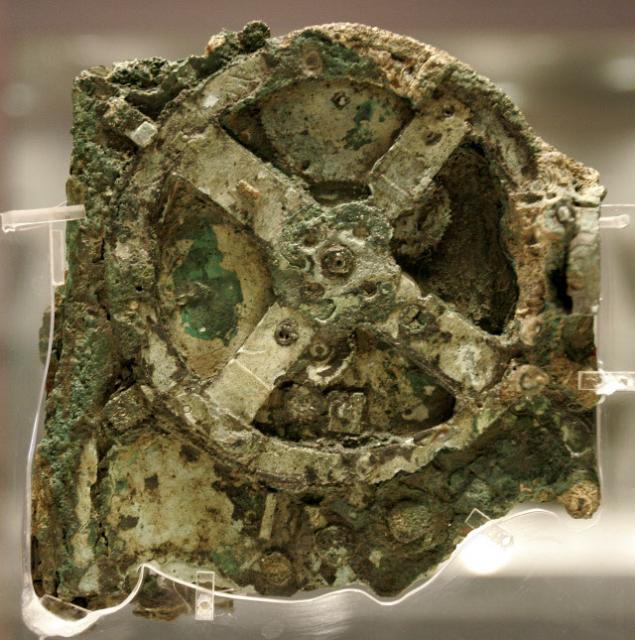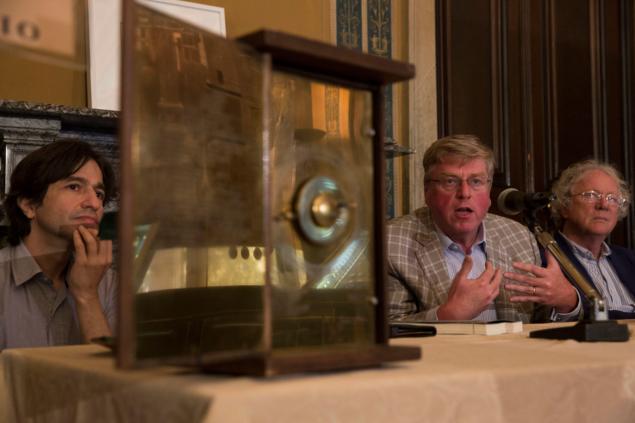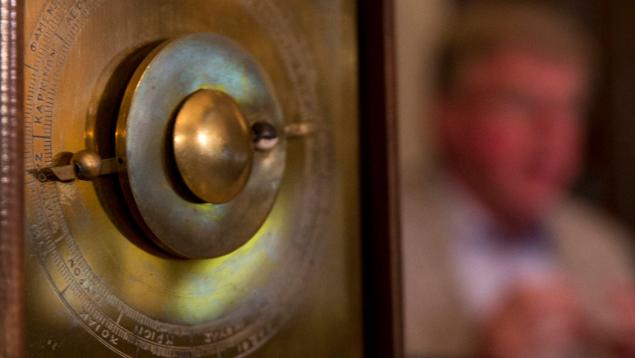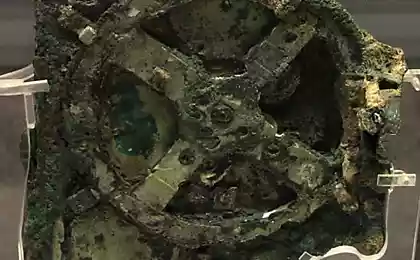938
Guide to the Antikythera Mechanism has helped scientists understand the purpose of the ancient computer
On reading it took about 12 years, but it was worth it

Photo: Petros Giannakouris / Associated Press
"How no one reads" - this statement clearly does not apply to archaeologists who carefully examined all the records in the ancient Greek language, related to the Antikythera Mechanism. It is called the first ever computer. Of course, this is not an electronic device, the mechanism of Antikythera is an analog system. Its age - about 2000 years.
This is probably one of the most impressive and important archaeological finds of all time historical science. The fact that no one thought that the Greeks are so advanced in the study of science and possessed knowledge and technology, allows you to create something similar. Antikythera Mechanism has shown that there is still much we do not know about the distant past of mankind.
The device is lifted in 1901 with an ancient ship that sank near the Greek island of Antikythera (Gr. Αντικύθηρα) and found the Greek diver April 4, 1900. It dated to about 100 BC, the year. e. (Possibly up to 150 years BC. E., Or 205 BC. E.). Stored in the National Archaeological Museum in Athens. More precisely determine the age of the machinery is not possible because the ship, which was carrying him, there were a lot of artifacts. These artifacts were created in very different time, so tie creation date Antikythera Mechanism to anything on the ship impossible.

Photo: The Associated Press
The mechanism comprises 37 bronze gears in a wooden case, on which were placed the arrow dials. Other devices of similar complexity unknown in Hellenistic culture. Approximate dimensions of the mechanism assembly -. 33 × 18 × 10 cm, it was announced the discovery of new fragments mechanism in 2005. In order to restore the position of the gears inside the coated mineral fragments took advantage of computed tomography using X-rays for taking three-dimensional maps of hidden content. Due to this, we were able to determine the relationship of the individual components and calculate their possible functional accessory.
Specialists in various fields of science and technology for many years studied the mechanism, making a single team - the research group The Antikythera Mechanism Research Project (AMRP). The study of the mechanism was carried out using the latest achievements of science and technology, including imaging, computer modeling, X-rays and so on. The team for the study of the mechanism consists of astronomers, engineers, archaeologists from different countries. More recently it has been the view that it is - an analog computer, predicting the movement of celestial bodies. In particular, scientists have suggested that this system showed the priests that happen solar or lunar eclipse. And it seems that scientists have made the correct conclusions.

Photo: Petros Giannakouris / Associated Press
The fact that the mechanism is provided with instructions for use. Instruction is divided into several parts. Some of the texts were about elements of the system, and some - on the surface of the "computer." The overwhelming majority of the texts are on the surface, almost destroyed by erosion, and read the texts found succeeded only now. To understand what difficulties faced scientists, imagine how the characters look the size of 1.2 mm engraved on a bronze surface, which had been in the water for two thousand years. Until recently, not only read, but also to find such symbols could not be due to the imperfections of the tools available to man. Total managed to find and read about 3400 characters (500 words). Although experts suggest that the mechanism of about 20 thousand characters was applied (respectively, about 2000-2500 words).
The researchers were not only able to read the characters found, but also to determine that they applied only two people working (presumably) in one workshop. The workshop was on the island of Rhodes, since the mechanism was "set up" to monitor the events in the astronomical latitude 35 ° N. w. Perhaps the mechanism was not the only one, and was part of a series of such "devices". If professionals can prove their point of view, the origin of the system will be able to associate with the ancient Greek astronomers such as Hipparchus (190-120 gg. BC. E.) And Geminus (I in. BC. E.). They conducted the study of "celestial mechanics" it is on the island of Rhodes. Closest to the aforesaid breadth was Hipparchus and Geminus lived in a specified period of time. On the other astronomers are able to perform such work (including Crete), historians at the moment unknown.
It is noteworthy that the descriptions that are relevant to the solar eclipse took place in view of the color of the eclipse. According to experts, this indicates that the device not only served as a scientific tool, use it to try to predict the future - both individual nations and the entire ancient civilization. "Some colors may indicate a positive change. If this is true, and we all interpreted correctly, the mechanism was larger astrological than astronomical tool, "- says one of the participants in the team of scientists who have studied the mechanism. The instruction itself is descriptive: it both to tell the viewer that it should be seen as a result of the mechanism. Explanations for the phenomena themselves do not have - the text is clearly drawn up for the person (people?) Who had specific knowledge of astronomy and astrology. The mechanism has shown its owner, as the movement of the celestial bodies affects the life of the ancient Greeks and their environment, and how the heavenly bodies affect the fate of nations in the future.

Photo: Petros Giannakouris / Associated Press
One of the most interesting questions about the old computer - for whom it was created, and where the customer lived? You may be able to learn, and this - in 2016, plans to conduct new excavations on the site of the crash of the ship, which was carrying mechanism. And if the new pieces of the mechanism will be found - it may help the puzzle completely. Or at least to supplement the already existing picture.
Source: geektimes.ru/post/277172/

Photo: Petros Giannakouris / Associated Press
"How no one reads" - this statement clearly does not apply to archaeologists who carefully examined all the records in the ancient Greek language, related to the Antikythera Mechanism. It is called the first ever computer. Of course, this is not an electronic device, the mechanism of Antikythera is an analog system. Its age - about 2000 years.
This is probably one of the most impressive and important archaeological finds of all time historical science. The fact that no one thought that the Greeks are so advanced in the study of science and possessed knowledge and technology, allows you to create something similar. Antikythera Mechanism has shown that there is still much we do not know about the distant past of mankind.
The device is lifted in 1901 with an ancient ship that sank near the Greek island of Antikythera (Gr. Αντικύθηρα) and found the Greek diver April 4, 1900. It dated to about 100 BC, the year. e. (Possibly up to 150 years BC. E., Or 205 BC. E.). Stored in the National Archaeological Museum in Athens. More precisely determine the age of the machinery is not possible because the ship, which was carrying him, there were a lot of artifacts. These artifacts were created in very different time, so tie creation date Antikythera Mechanism to anything on the ship impossible.

Photo: The Associated Press
The mechanism comprises 37 bronze gears in a wooden case, on which were placed the arrow dials. Other devices of similar complexity unknown in Hellenistic culture. Approximate dimensions of the mechanism assembly -. 33 × 18 × 10 cm, it was announced the discovery of new fragments mechanism in 2005. In order to restore the position of the gears inside the coated mineral fragments took advantage of computed tomography using X-rays for taking three-dimensional maps of hidden content. Due to this, we were able to determine the relationship of the individual components and calculate their possible functional accessory.
Specialists in various fields of science and technology for many years studied the mechanism, making a single team - the research group The Antikythera Mechanism Research Project (AMRP). The study of the mechanism was carried out using the latest achievements of science and technology, including imaging, computer modeling, X-rays and so on. The team for the study of the mechanism consists of astronomers, engineers, archaeologists from different countries. More recently it has been the view that it is - an analog computer, predicting the movement of celestial bodies. In particular, scientists have suggested that this system showed the priests that happen solar or lunar eclipse. And it seems that scientists have made the correct conclusions.

Photo: Petros Giannakouris / Associated Press
The fact that the mechanism is provided with instructions for use. Instruction is divided into several parts. Some of the texts were about elements of the system, and some - on the surface of the "computer." The overwhelming majority of the texts are on the surface, almost destroyed by erosion, and read the texts found succeeded only now. To understand what difficulties faced scientists, imagine how the characters look the size of 1.2 mm engraved on a bronze surface, which had been in the water for two thousand years. Until recently, not only read, but also to find such symbols could not be due to the imperfections of the tools available to man. Total managed to find and read about 3400 characters (500 words). Although experts suggest that the mechanism of about 20 thousand characters was applied (respectively, about 2000-2500 words).
The researchers were not only able to read the characters found, but also to determine that they applied only two people working (presumably) in one workshop. The workshop was on the island of Rhodes, since the mechanism was "set up" to monitor the events in the astronomical latitude 35 ° N. w. Perhaps the mechanism was not the only one, and was part of a series of such "devices". If professionals can prove their point of view, the origin of the system will be able to associate with the ancient Greek astronomers such as Hipparchus (190-120 gg. BC. E.) And Geminus (I in. BC. E.). They conducted the study of "celestial mechanics" it is on the island of Rhodes. Closest to the aforesaid breadth was Hipparchus and Geminus lived in a specified period of time. On the other astronomers are able to perform such work (including Crete), historians at the moment unknown.
It is noteworthy that the descriptions that are relevant to the solar eclipse took place in view of the color of the eclipse. According to experts, this indicates that the device not only served as a scientific tool, use it to try to predict the future - both individual nations and the entire ancient civilization. "Some colors may indicate a positive change. If this is true, and we all interpreted correctly, the mechanism was larger astrological than astronomical tool, "- says one of the participants in the team of scientists who have studied the mechanism. The instruction itself is descriptive: it both to tell the viewer that it should be seen as a result of the mechanism. Explanations for the phenomena themselves do not have - the text is clearly drawn up for the person (people?) Who had specific knowledge of astronomy and astrology. The mechanism has shown its owner, as the movement of the celestial bodies affects the life of the ancient Greeks and their environment, and how the heavenly bodies affect the fate of nations in the future.

Photo: Petros Giannakouris / Associated Press
One of the most interesting questions about the old computer - for whom it was created, and where the customer lived? You may be able to learn, and this - in 2016, plans to conduct new excavations on the site of the crash of the ship, which was carrying mechanism. And if the new pieces of the mechanism will be found - it may help the puzzle completely. Or at least to supplement the already existing picture.
Source: geektimes.ru/post/277172/
Archaeologists have discovered a previously unknown ancient construction in Jordan thanks to satellite imagery and drones
release























